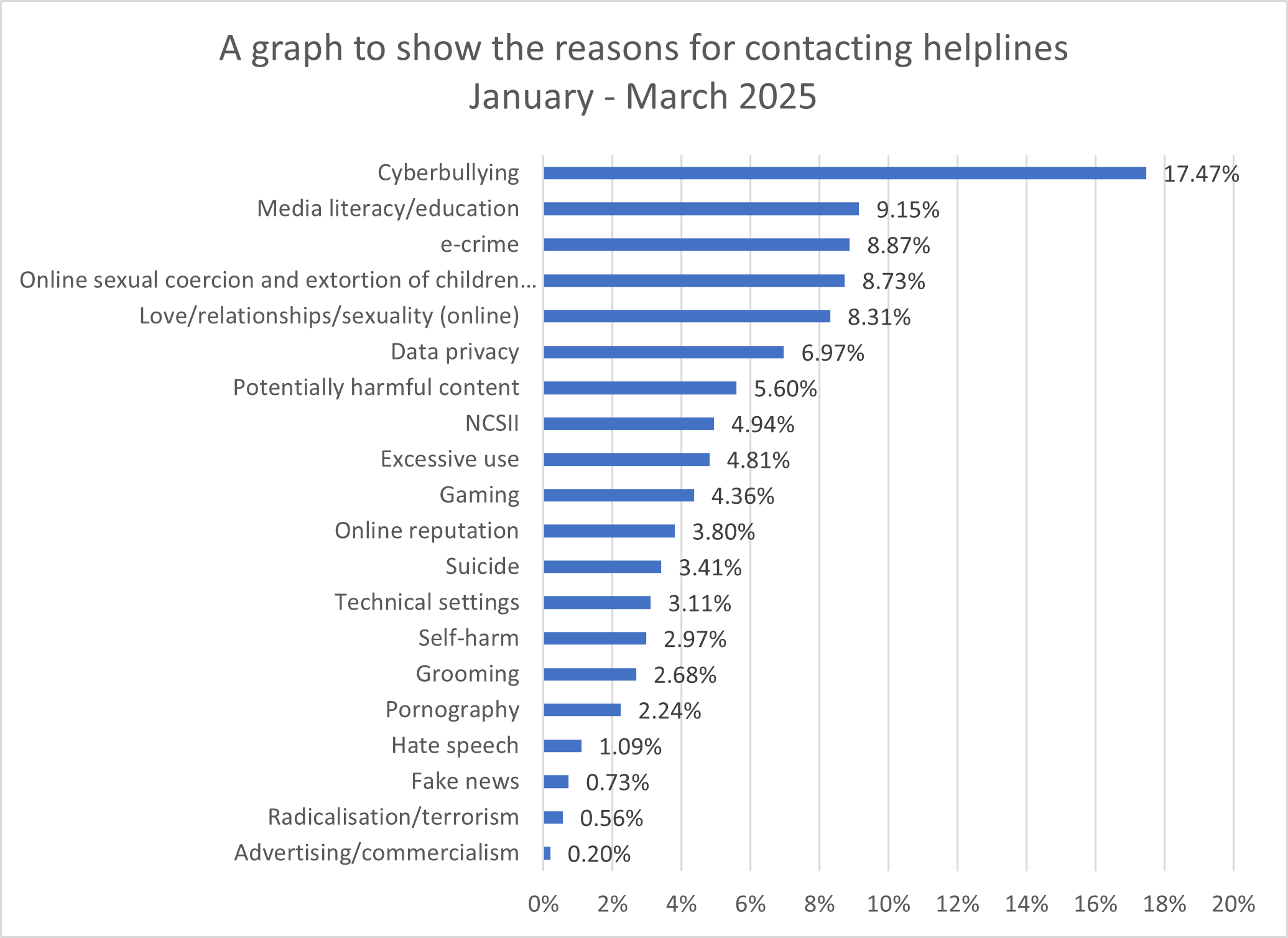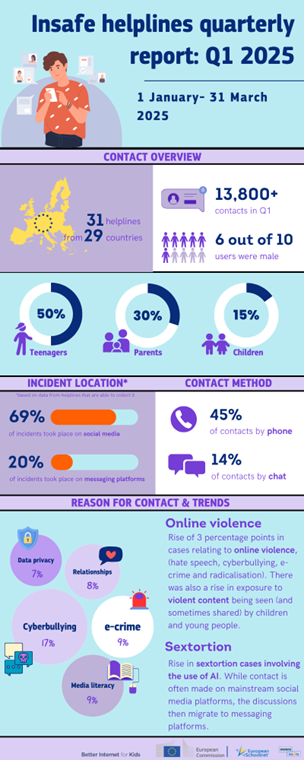The Insafe network of helplines collects data about the types of calls received, and this is analysed every three months in order to look at possible trends and emerging issues.

The most recent helpline data covers the period from January to March 2025. There were over 13,800 contacts made to the network, representing an increase of almost 9 per cent compared to the previous reporting period.
Almost 50 per cent of contacts came from teens (12-18) and 15 per cent from the youngest users (5-12). Over time, there has been a gradual reduction in the percentage of teens using helplines, alongside a corresponding increase in contacts from the 5- to 12-year-old age group. Although there are some fluctuations when comparing reporting periods, teens consistently account for the greatest number of contacts.
The phone remains the most common way to contact a helpline, with 45 per cent of helpline users getting in touch in this way. There has been a reduction in contacts made using chat facilities, but helplines continue to offer a wide range of methods to contact them.
Where possible, helplines capture information about where a particular problem occurred (for example, on messaging services, social media platforms, games, and so on). During Q1 2025, 68 per cent of issues occurred on social media, 20 per cent on messaging services, and 8 per cent on gaming platforms. The main reason for contacting a helpline is cyberbullying. This represents a 2.5 percentage point increase since the previous quarter. Cyberbullying is consistently the most common issue that helplines are dealing with, and indeed, the European Commission has highlighted cyberbullying with a commitment to develop an Action Plan against cyberbullying highlighted in the new political priorities.
There has been a reduction in the percentage of contacts relating to both self-harm and suicide. In terms of the number of contacts, there has been a reduction in contacts about self-harm but an increase in contacts related to suicide.
The last quarter saw a reduction of two percentage points in the online sexual coercion and extortion of children (OSEC; sometimes referred to as sextortion), but noted that the actual number of contacts relating to this had increased since the previous reporting period. This quarter has seen a two percentage point increase, bringing the percentage of contacts about OSCEC back to nine, with numbers rising by 36 per cent.
Insafe contacts are now grouped into four main areas:
- Being online (incorporating advertising and commercialism, data privacy, fake news, media literacy/education, potentially harmful content, self-harm, suicide and technical settings. This area accounted for 32 per cent of all contacts, representing a four percentage point reduction from the previous quarter.
- Online violence (incorporating cyberbullying, e-crime, hate speech and radicalisation/terrorism) and this accounted for 28 per cent of all contacts, which is a rise of three percentage points since Q4 in 2024.
- Online activities/relations (incorporating excessive use, gaming, love, relationships, sexuality (online), online reputation and pornography) which accounted for 24 per cent of all calls; a slight increase of one percentage point since the previous quarter.
- Online sexual abuse and violence (incorporating grooming, the non-consensual sharing of intimate images (NCSII) and the online sexual coercion and extortion of minors (which used to be referred to as sextortion)). This area accounted for 16 per cent of all contacts made, the same as in the previous reporting period. The table below shows the percentage of contacts assigned to each category.

| Advertising/commercialism | 0.20% |
|---|---|
| Radicalisation/terrorism | 0.56% |
| Fake news | 0.73% |
| Hate speech | 1.09% |
| Pornography | 2.24% |
| Grooming | 2.68% |
| Self-harm | 2.97% |
| Technical settings | 3.11% |
| Suicide | 3.41% |
| Online reputation | 3.80% |
| Gaming | 4.36% |
| Excessive use | 4.81% |
| NCSII | 4.94% |
| Potentially harmful content | 5.60% |
| Data privacy | 6.97% |
| Love/relationships/sexuality (online) | 8.31% |
| Online sexual coercion and extortion of children (sextortion) | 8.73% |
| e-crime | 8.87% |
| Media literacy/education | 9.15% |
| Cyberbullying | 17.47% |
The infographic below provides a visual representation of many of the key points in the first quarter of 2025, all in the text above, from January to March.

Find out more about country-based helpline services, operating as part of the national Safer Internet Centre and keep up to date with news on helpline services and trends.
The Insafe network of helplines collects data about the types of calls received, and this is analysed every three months in order to look at possible trends and emerging issues.

The most recent helpline data covers the period from January to March 2025. There were over 13,800 contacts made to the network, representing an increase of almost 9 per cent compared to the previous reporting period.
Almost 50 per cent of contacts came from teens (12-18) and 15 per cent from the youngest users (5-12). Over time, there has been a gradual reduction in the percentage of teens using helplines, alongside a corresponding increase in contacts from the 5- to 12-year-old age group. Although there are some fluctuations when comparing reporting periods, teens consistently account for the greatest number of contacts.
The phone remains the most common way to contact a helpline, with 45 per cent of helpline users getting in touch in this way. There has been a reduction in contacts made using chat facilities, but helplines continue to offer a wide range of methods to contact them.
Where possible, helplines capture information about where a particular problem occurred (for example, on messaging services, social media platforms, games, and so on). During Q1 2025, 68 per cent of issues occurred on social media, 20 per cent on messaging services, and 8 per cent on gaming platforms. The main reason for contacting a helpline is cyberbullying. This represents a 2.5 percentage point increase since the previous quarter. Cyberbullying is consistently the most common issue that helplines are dealing with, and indeed, the European Commission has highlighted cyberbullying with a commitment to develop an Action Plan against cyberbullying highlighted in the new political priorities.
There has been a reduction in the percentage of contacts relating to both self-harm and suicide. In terms of the number of contacts, there has been a reduction in contacts about self-harm but an increase in contacts related to suicide.
The last quarter saw a reduction of two percentage points in the online sexual coercion and extortion of children (OSEC; sometimes referred to as sextortion), but noted that the actual number of contacts relating to this had increased since the previous reporting period. This quarter has seen a two percentage point increase, bringing the percentage of contacts about OSCEC back to nine, with numbers rising by 36 per cent.
Insafe contacts are now grouped into four main areas:
- Being online (incorporating advertising and commercialism, data privacy, fake news, media literacy/education, potentially harmful content, self-harm, suicide and technical settings. This area accounted for 32 per cent of all contacts, representing a four percentage point reduction from the previous quarter.
- Online violence (incorporating cyberbullying, e-crime, hate speech and radicalisation/terrorism) and this accounted for 28 per cent of all contacts, which is a rise of three percentage points since Q4 in 2024.
- Online activities/relations (incorporating excessive use, gaming, love, relationships, sexuality (online), online reputation and pornography) which accounted for 24 per cent of all calls; a slight increase of one percentage point since the previous quarter.
- Online sexual abuse and violence (incorporating grooming, the non-consensual sharing of intimate images (NCSII) and the online sexual coercion and extortion of minors (which used to be referred to as sextortion)). This area accounted for 16 per cent of all contacts made, the same as in the previous reporting period. The table below shows the percentage of contacts assigned to each category.

| Advertising/commercialism | 0.20% |
|---|---|
| Radicalisation/terrorism | 0.56% |
| Fake news | 0.73% |
| Hate speech | 1.09% |
| Pornography | 2.24% |
| Grooming | 2.68% |
| Self-harm | 2.97% |
| Technical settings | 3.11% |
| Suicide | 3.41% |
| Online reputation | 3.80% |
| Gaming | 4.36% |
| Excessive use | 4.81% |
| NCSII | 4.94% |
| Potentially harmful content | 5.60% |
| Data privacy | 6.97% |
| Love/relationships/sexuality (online) | 8.31% |
| Online sexual coercion and extortion of children (sextortion) | 8.73% |
| e-crime | 8.87% |
| Media literacy/education | 9.15% |
| Cyberbullying | 17.47% |
The infographic below provides a visual representation of many of the key points in the first quarter of 2025, all in the text above, from January to March.

Find out more about country-based helpline services, operating as part of the national Safer Internet Centre and keep up to date with news on helpline services and trends.
- helpline data cyberbullying media education commercialism cyberviolence
Related content
- < Previous article
- Next article >












